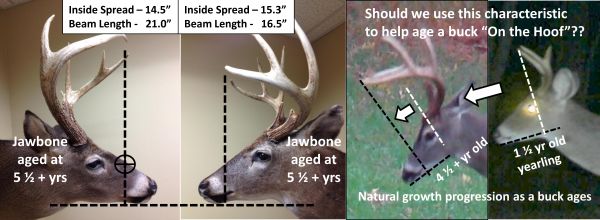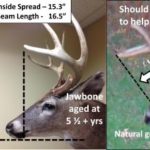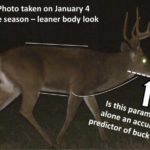
How far can we accurately push the envelope?
In the January issue we covered the topic of “aging bucks on the hoof.” As pointed out, the art of “eyeball aging” of live bucks has traditionally relied on their being classified by relatively clear physiological body characteristics, patterns of behavior and relative antler size differences. This is, by no means, an exact science and is to a degree “in the eye of the beholder,” and requires lots of experience to be reliably accurate. This is true whether one is talking about a personal encounter with a buck in the field, or one is studying a trail camera photo.
One particular problem that I encounter year after year has to do with the fact that physiologically bucks can be transformed over a period of weeks during the pre-rut and rut from huge 200-plus-pound behemoths into lean, gaunt shadows of their previous selves. During that annual time period they are on their feet almost constantly wandering, chasing and breeding and they lose an astonishing percentage of weight. I have followed this phenomenon from year to year through trail camera surveillance. Typically, from my own personal experience here in the Deep South, bucks often appear to be a year or so younger than they really are when viewed from late December on, as compared to what their perceived age would appear to be in October or early November. I once harvested a big old mature brute that I had been after for two straight years. In late October and early November he was a classic huge bodied buck that weighed well over 200 pounds. When he was harvested the first week of January, to my surprise, he only weighed 160 pounds undressed. If it were not for his characteristic rack I would have never recognized him at all. To help alleviate this particular visual assessment problem it would be very helpful to have an additional fairly accurate visual tool that was independent of body physiology. Would that even be possible?
In Mississippi, the current antler regulations for harvestable deer are wonderful, in the sense that we are all now seeing bigger and older deer than we ever did in the past. Regarding what characteristics define a legal buck, the state of Mississippi is divided into three “harvest zones.” In zones “1” and “2” a legal buck must have either a minimum inside spread of 10 inches or one main beam at least 13 inches long. In zone “3” a legal buck must have either a minimum inside spread of 12 inches or one main beam at least 15 inches long. In the Outdoor Digest of regulations for Mississippi published each year by the MDWFP, simple diagrams are provided that visually illustrate how to estimate a buck’s inside spread using face-on ear-tip to ear-tip dimensions, and how to estimate a buck’s main beam length using a side view assessment of where the tip of the main beam falls vertically between the front of the eye and the tip of the nose. The particular parameters that are used to define what constitutes a legal buck in Mississippi also appear to correlate roughly with relative age based on the changing geometry of a buck’s rack as he ages, but is this relationship accurate enough to be practical for field use? The minimum antler criteria for a legally harvestable buck in Mississippi were specifically designed to protect most 1 ½-year-old bucks and a fair amount of 2 ½-year-old bucks statewide.
I personally love the new buck harvest regulations, as do most hunters that I have spoken to. The flip side though is that with state-regulated minimum antler criteria to consider, plus mature buck age thresholds to assess on many private parcels and clubs, bucks seldom cooperate and stride by as if on a parade field, stopping and giving the hunter standing frontal and side views. In most instances, I would hazard to guess, buck harvest decisions are made quickly under far less than ideal conditions that include movement, visibility and/or distance issues. In order to properly and quickly judge a buck’s legality or age classification in the field, we need every possible visual aid that is available to help us quickly make a proper shoot or no shoot decision. In cases where buck age is an additional consideration for buck harvest, the same less than ideal field conditions often come into play. As a result, physiological body characteristics, and patterns of behavior often become difficult or impossible to quickly assess.
As touched on earlier, one potential way “in the field” to help us quickly solve the “what age is he?” dilemma, might potentially involve an extrapolation of the very same concept that is used by the MDWFP to define a minimum legal buck in Mississippi. If viable, would it be accurate? To this end, I recently became intrigued by an article that I read in a national deer hunting magazine that covered this same topic. The subject article concerned the use of certain visual geometric clues regarding the relationship of the tips of the antler beams to the eye and/or nose when viewed from the side, to reliably judge buck age in the field. According to the article, deer management personnel in a northeastern state noticed in the mid-1990s a consistent pattern when the antler tip relationship to the eye was compared to actual tooth wear dated age on harvested bucks. For the following several years biologists and technicians with that state’s wildlife agency measured and noted the parameters of this relationship as they compiled harvest data from several management cooperatives. This method was reported to be quite reliable for estimating a buck’s actual age in one of four general age classifications, either as a 1 ½-year-old yearling, a 2 ½-year-old, a 3 ½-year-old or a 4 ½-year-old. The basis for this method involves the fact that generally as a whitetail buck gets older, his main beams continuously develop outward and down, as well as forward and down. It was reported that after ground checking more than two thousand harvested bucks over a several year period, and comparing lower jaw tooth wear age with the antler tip to eye relationship, the method was found to be surprisingly accurate. I am currently checking with deer scientists here in Mississippi as well as regionally to get their thoughts on this topic and to see what research might or might not have already been done along these same lines. To my knowledge, here in the deep-south, there have been no studies to date specifically targeting antler tip position in relationship to the eye and/or nose as an accurate independent predictor or visual cue to a buck’s age.
Intuitively, it would seem that this method might work with some degree of general accuracy in this region. A recent Deer Program Report published by the MDWFP Deer Committee has a table of statewide compiled buck harvest data for the time period of 2005 through 2009 showing the steady year-by-year progression of antler main beam length growth, from an average length of 6.5 inches for a 1 ½-year-old, to an average length of 19.7 inches for a 4 ½ plus year old. Hmmm — that sounds interesting, but can that pattern actually be translated into an accurate visual aging tool? I will continue to look into this in more detail and will report back in a future column as to what I find out regarding the possibility of using this very interesting concept as an additional visual aging tool in the field. If any readers have thoughts or data that might have a bearing on this topic, please get in touch with me through the magazine.




